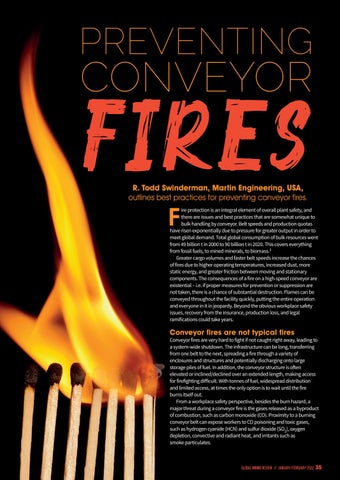R. Todd Swinderman, Martin Engineering, USA, outlines best practices for preventing conveyor fires.
F
ire protection is an integral element of overall plant safety, and there are issues and best practices that are somewhat unique to bulk handling by conveyor. Belt speeds and production quotas have risen exponentially due to pressure for greater output in order to meet global demand. Total global consumption of bulk resources went from 49 billion t in 2000 to 90 billion t in 2020. This covers everything from fossil fuels, to mined minerals, to biomass.1 Greater cargo volumes and faster belt speeds increase the chances of fires due to higher operating temperatures, increased dust, more static energy, and greater friction between moving and stationary components. The consequences of a fire on a high-speed conveyor are existential – i.e. if proper measures for prevention or suppression are not taken, there is a chance of substantial destruction. Flames can be conveyed throughout the facility quickly, putting the entire operation and everyone in it in jeopardy. Beyond the obvious workplace safety issues, recovery from the insurance, production loss, and legal ramifications could take years.
Conveyor fires are not typical fires
Conveyor fires are very hard to fight if not caught right away, leading to a system-wide shutdown. The infrastructure can be long, transferring from one belt to the next, spreading a fire through a variety of enclosures and structures and potentially discharging onto large storage piles of fuel. In addition, the conveyor structure is often elevated or inclined/declined over an extended length, making access for firefighting difficult. With tonnes of fuel, widespread distribution and limited access, at times the only option is to wait until the fire burns itself out. From a workplace safety perspective, besides the burn hazard, a major threat during a conveyor fire is the gases released as a byproduct of combustion, such as carbon monoxide (CO). Proximity to a burning conveyor belt can expose workers to CO poisoning and toxic gases, such as hydrogen cyanide (HCN) and sulfur dioxide (SO2), oxygen depletion, convective and radiant heat, and irritants such as smoke particulates.
global mining review // January/February 2022
35














